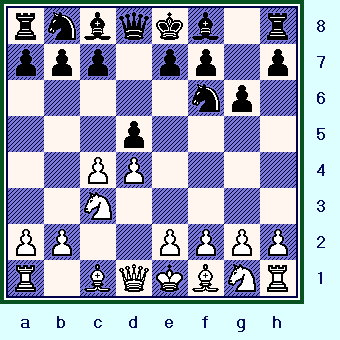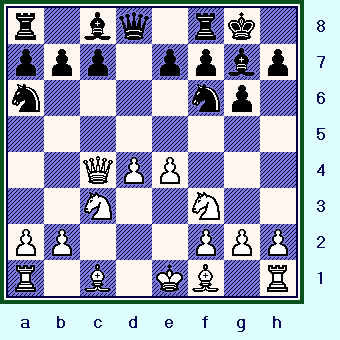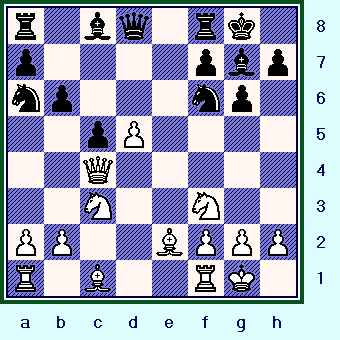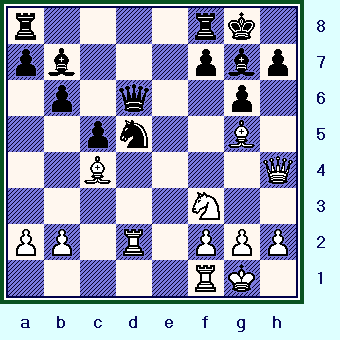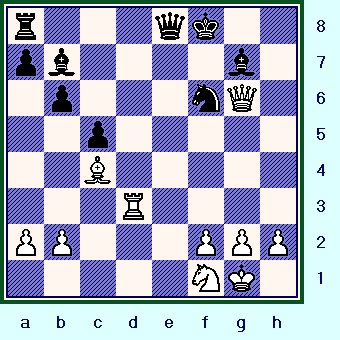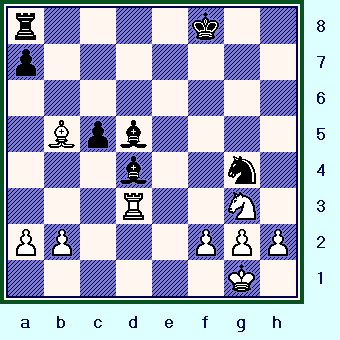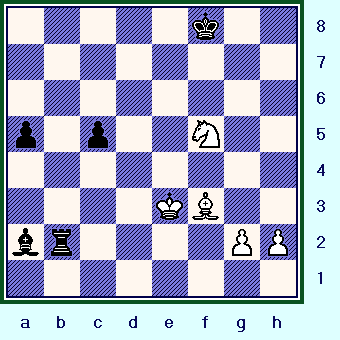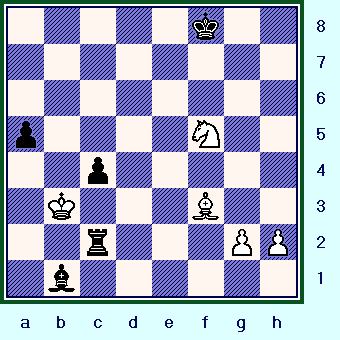GM
Sergei Volkov (2612) - GM Emil Sutovsky (2669)
|
|
|
"GAME OF THE MONTH," March, 2005.
This struggle was critical for the titanic fight for first place in this tournament.
I have been to dozens - perhaps even hundreds? - of tournaments. And more times than I can count, I would have loved to see the "big guns" duke it out for all the marbles. Yet time after time, the only thing you get to see is the perfunctory smile and handshake ... and if you blink, you might not even get to see that! (I have witnessed many incidents where the titled players will agree to a draw, and NOT even play a single move on the chess board!!! Yet I once agreed to a draw in the last round of a tournament in only twelve moves. I was a little tired, having defeated two straight masters in very emotionally draining struggles. I also felt I had not slept the night before, I was exhausted. The TD in this event FORFEITED me, citing some arcane rule against short or pre-arranged draws. Normally, I would not complain, but the same TD completely ignored the fact that two titled players agreed to a draw in one of his events, about two months later, ... ... ... WITHOUT EVEN SITTING DOWN AT THE CHESSBOARD!!!!!!!! Can we say, "Double standard," boys and girls? Of course other words - like 'hypocrite' - also come to mind. And I appealed this decision to the spineless bureaucrat at USCF, and they even sided with the TD!)
All my complaining and airing of past grievances aside, I am sure I am not the only chess fan who has been disappointed by a fast draw in a key, last round encounter. Here, we get to see a player -- who needed to win against a highly-rated opponent with the BLACK pieces!! -- and he manages to do exactly that. (I can only envy the spectators who were able to see this magnificent struggle in person!) And since this game was so important to the outcome of one of the biggest (open) tournaments on the face of the earth, it became ... ... ... DE FACTO! ... ... ... my game for this month's column.
*******
(Thanks must go to a gentleman in Texas - who asked not to be named.
He sent in a donation and told me in
his letter: "Make this month special."
---> Apparently his son's birthday
occurs during the month of March,
or maybe soon after. Happy Birthday & Enjoy!!!)
*******
Editor's note: At first I was going to make like five extra web pages for this month. (Click here to see one example.) But after much work, I realized that I would never finish the game in time! I then decided to incorporate games like Anand-Kasparov, {see below} into the body of this game, rather than give this encounter its own separate web page.
There were several other games that I annotated, like Spassky-Fischer; Siegen 1970, {see below}; as part of my preparation for this page. (I still intend to give this game its own separate web page, and I have developed an entire {brief} theoretical survey of The Exchange Variation to go along with it. The game is already {over} 75% annotated, and I am still working on it.)
In order to - FINALLY - get this game formatted and finished, I had to forego several of these games. Otherwise it would be June and this page ... and all the associated links that I was planning to create for it ... would never be completed!! (March 23, 2005.)
The ratings are accurate, and have been checked against the FIDE website.
1.d4 Nf6;
2.c4 g6; 3.Nc3 d5; {See the
diagram - just below.}
The Grunfeld Defense - a personal
favorite of mine. (I played this system
as my main defense to the QP opening
for nearly 25 years in rated, tournament
play. I stopped only on the advice of a
GM - and only because I was allowing
too many draws against lower-rated
players ... the bane of any master.)
***********************************
***********************************
Personal feelings aside, this opening
is based on solid ideas - and is very
good for any amateur to play.
(Not many top GM's play this opening
today, Garry Kasparov used to play
it in his youth, but no longer uses it.)
Perhaps the main reason why GM's
don't use this system too much at
the highest level is that the results
tend to
clearly favor White. And this
is not just some personal bias, but
is based on about a 10-year study of books,
The Informant(s), and also statistics pulled from my own db.
The pawn advance of ...d7-d5 affects many key squares, and has a long-term impact on the game as a whole.
[ After the moves:
3...Bg7; 4.e4 d6;
{Diagram?}
we have ... ... ... a
"King's Indian
Defense."
]
4.Nf3,
A very natural developing move
that controls the center and gets a
Knight off the back row.
(It covers
another opening principle, as it also
prepares castling.)
This move is an inherent part of many
different opening branches in the
Grunfeld Defense ...
but, of course,
it is not the only move available for
White at this point!
[ White can also play the following
continuation:
4.cxd5 Nxd5;
5.e4 Nxc3; 6.bxc3 Bg7; 7.Bc4,
{Diagram?}
The older, time honored way of
playing ... "The Exchange Variation."
(This move was once considered
almost obligatory for White, today
there are many different plans ...
and variations! ... for White from
this particular position.)
(
White can also play: 7.Nf3, {Diagram?} in this position as well.
(This is
actually a relatively newer line.
At one time - it was considered
a mistake to play Nf3 here.)
[ See any modern reference work for more information on these interesting lines.] )
7...c5; 8.Ne2 Nc6; 9.Be3 0-0;
10.0-0 Qc7; {Diagram?}
A move that was first played by
L. Shamkovich but was refined
into a formidable weapon by
{former} World Champion, (GM)
Vassily
Smyslov.
( The other line for Black is: 10...cxd4!?; 11.cxd4 Bg4;
12.f3 Na5!?; 13.Bd3! Be6 "~"
with continuing complications. )
11.Rc1 Rd8;
{Diagram?}
One of the key positions for this
whole line. (All this was/is 'book.')
12.h3!?,
(hmmm)
{Diagram?}
This idea had a bad reputation at
the time, ever since Gligoric had lost
to Vassily Smyslov in this variation.
(Today the main 'book' moves - in
the position after Black's eleventh
move - are Qd2! and also Bf4!?)
The idea behind this move is to
prevent Black from playing ...Bg4;
and continue on with K-side play.
( Also interesting for White would be: 12.Qa4!?, "+/=" with some advantage. )
12...b6!?; 13.f4! e6; 14.Qe1 Na5!?;
15.Bd3 f5!; 16.g4!? fxe4!?; 17.Bxe4 Bb7;
18.Ng3 Nc4;
19.Bxb7 Qxb7; 20.Bf2, ('!')
{Diagram?}
The wisest move here.
( Also possible was: 20.dxc5!? )
Now White comes up with a very
bold plan, that involves a Pawn
sacrifice. BOTH sides play to win!
20...Qc6; 21.Qe2! cxd4; 22.cxd4 b5;
23.Ne4! Bxd4; ('!?') {Diagram?}
This move has been criticized by
some, but it seems natural to me.
Further - it is the first choice of
nearly every program that I have
tested this game on!
24.Ng5 Bxf2+!?; 25.Rxf2 Rd6!?; 26.Re1 Qb6!?;
27.Ne4!? Rd4, "+/=" {Diagram?}
Nearly every program that I have
utilized to evaluate this contest,
shows a fair-size edge for Black
("/+") at this particular point in this
historic, over-the-board combat.
28.Nf6+ Kh8!; 29.Qxe6 Rd6;
{Diagram?}
Black feels that he cannot exchange
Queens in this position.
( The sneaky try of: 29...Rd1!?; ('?!') fails to the ultra-brilliant 30.Qf7!!,
"+/-"
when White will win after all the
dust has finally settled. (E. Mednis)
{This analysis was confirmed by
Kasparov, see "M.G.P. Vol. III."} )
30.Qe4 Rf8!?; ('?!')
{Diagram?}
Nearly every author who has looked
at this game has pointed out that
Fischer had a better move here.
( An improvement was: >/= 30...Rad8!; 31.g5
Rd2!; "~" {Diagram?}
when Fischer has enough play
to hold the fort - he should not
lose from
this position. (Although
it is doubtful if Bobby ever had
enough play to
win this fight.) )
31.g5 Rd2; 32.Ref1 Qc7?;
{Diagram?}
This is the losing move. Black
had to play his Rook to c8 here.
(So that if White plays Qe7, Black
can respond with ...Qc7; to be
able to defend his h7-square.)
Now Spassky sacrifices an "ox,"
a truly brilliant and inspired way to
win this fantastic conflict.
33.Rxd2!! Nxd2;
{Diagram?}
One writer - who was present in
the hall when this game was
actually played - wrote that a
ripple went
through the crowd,
some thought Spassky was now
losing this titanic battle.
34.Qd4! Rd8!?; 35.Nd5+ Kg8;
36.Rf2 Nc4[]; 37.Re2! Rd6; ('??')
{Diagram?}
This is definitely a mistake, that
much is very clear. However, it
also comes in a position that was
already
VERY bad (lost) for Black.
( Black had to play: >/= 37...Qd6!; {Diagram?}
Now White wins by playing:
38.Re7! Qb6[]; 39.Re8+! Rxe8[]; 40.Nxb6 Nxb6; 41.Kf2! , "+/-"
{D?}
White's whole Queen is much
better than Black's R and N. (But it is a very
obvious and a
very large improvement over
the course of the actual game.) )
38.Re8+ Kf7; 39.Rf8+!, "+/-" Black Resigns, 1-0. [re-play]
One of the greatest games of
that period, and a truly magnificent
struggle.
>> A truly epic clash! <<
GM
Boris Spassky - GM
Robert J. ("Bobby")
Fischer;
(FIDE) World Team Championships
( This tournament is better, more commonly known as the "The
Olympiad," which is a biennial event. )
Siegen, West Germany; 1970. {1-0,
39 moves.}
*******
This famous game can be found
in dozens of books, including all
the numerous collections
of Boris
Spassky's best chess games.
(It can also be found in GM Garry
Kasparov's book,
{2004, Everyman};
"My Great Predecessors, Part III.")
Two of my favorites are:
# 1.)
"How To Beat Bobby Fischer,"
by {the late} GM Edmar Mednis.
{Originally published in 1974.}
# 2.)
The book of the tournament
that contains many comments by
the actual players
that was taken
from numerous newspaper columns
and magazine reports. (In German.)
** ** ** ** ** ** ** ** ** ** ** ** ** ** ** ** ** ** ** ** ** ** ** ** ** ** ** ** ** **
{Soon - I hope to have this game
annotated on its own web page. This would include a brief
theoretical
survey of the opening as well.} ]
4...Bg7; 5.Qb3!?,
This is often referred to as ... "The Russian System,"
primarily
because it was the Soviet-era
players
who first analyzed and used this line.
(MCO-14 refers to this line as ...
"The Classical Variation" of the
Grunfeld Defense.)
The idea behind this continuation is to
force Black to give up his hold on the
center. (The d5-point.)
The main
drawback is that White loses some
time with the Queen.
[ White can still play a
modified version
of ... "The Exchange Variation,"
by using the following continuation:
5.cxd5 Nxd5; 6.e4 Nxc3; 7.bxc3 c5;
8.Rb1 0-0; 9.Be2 cxd4;
10.cxd4 Qa5+; 11.Bd2 Qxa2; 12.0-0,
"~" {Diagram?}
In this position, White has very good
play for the sacrificed Pawn.
There
are literally hundreds of games in the
database that have been
played from
this position.
A good example is:
GM Vladimir Kramnik -
GM Veselin Topalov;
ICT /
Super-GM
XV
(Invitational, R9)
/
Linares, ESP; 1998.
(0.5 - 0.5)
{This game was an extremely
tough battle, but was eventually
drawn
in over fifty
moves. You should be able to find this game here.}
Dozens of other top players have
debated this position as well.
(Including Kramnik and Kasparov.)
]
5...dxc4;
6.Qxc4 0-0; 7.e4, ("+/=")
The normal and natural move ...
White dominates the center and
gains a small - but very solid edge.
[ By playing the (reasonable) moves:
7.Bf4!? c6; 8.e4 Nbd7!;
9.Rd1!? Nb6; 10.Qc5!? Bg4!;
{Diagram?}
we reach a position that is full of
tension, with 11.Be2,
"+/="
White will
probably retain at least a slight
advantage. (Instead, IM Donald
Byrne played
the slightly dubious
move of 11.Bg5!? which was refuted
in a really spectacular
fashion. {Click
here for more
information, and to replay this game.}
]
7...Na6!?;
(Interesting.)
{See
the diagram given - just below here.}
This is known as ... "The Prins System." [more]
(Named after a Dutch IM ... who
was the first to play and use this
move on a regular basis.
The Russian
GM, V. Ragozin also used this line.)
***********************************
***********************************
For many years this was considered to
be a side-system and was frowned
upon by theory ...
or at least it was
when I first started playing chess.
<< Positionally - this whole variation
is a little suspect, ... >>
- IM William Hartston, in his book.
<< Popular in some circles, but it
is doubtful if this line is sound, or
even fully playable for Black. >>
- GM Svetozar Gligoric, writing for
the U.S. chess magazine over 25
years ago.
*******
Today - in a Yearbook that is less
than four years old - the author of
a theoretical survey awards 7...Na6;
an exclam, ('!') and calls this system: "one of Black's most reliable choices,
and one of the richest fields for
any
enterprising player to dig in."
GM Bogdan Lalic - in his 1997 book
on the Grunfeld - has mostly positive
things to say about this system,
and
seems to be indicating that this
system is both sound and playable.
What brought about this reversal?
One of the biggest changes in the
theoretical opinions about this whole
variation, came after none other than
GM Garry Kasparov adopted this move
in his 1986 World Championship
Match against GM Anatoly Karpov.
(And although Garry lost that game,
his use of the line encouraged others
to investigate this system even more.)
"Since then, this half-forgotten system
has become much more popular
in tournament practice" - GM L. Shamkovich & Jan Cartier
The idea of this system is relatively
simple, Black develops and prepares
the counter-strike of ...c7-c5; on
White's
dominating center. The big
question is: "Will the Knight on the
edge of the board be out of play?"
As many authors have noted, the play
of this whole (sub) system is extremely
complex and difficult. If Black makes
one mis-step, it is often fatal!
*********************
[ Another popular line for Black ...
from the position after White
plays e2-to-e4 ...
is the following continuation:
7...a6!?;
{Diagram?}
Some books refer to this as the
"Hungarian System," in honor of
all those players
from that country
who pioneered and played this line.
8.Be2! b5; 9.Qb3 Bb7;
10.e5 Nd5; 11.0-0 Nxc3; 12.Qxc3,
"+/=" {Diag?}
with a small - but solid edge for
White in this position.
See the contest:
GM Gennadi Sosonko
(2602) - GM
Gyula Sax (2579);
/ ICT - Lubljana/Portoroz; 1977.
{White won a sharp game in
forty-seven total moves.} ]
The next few moves are all book.
8.Be2! c5; 9.d5 e6; 10.0-0 exd5; 11.exd5 b6!?;
{See the diagram ... given just below.}
An interesting move ... Black stops
and reinforces the Q-side, especially
the c5-square here. However, I am
not sure what the exact theoretical
verdict of this move is. (Most programs
award White a fairly large, and rather
solid edge in this particular position.
The CB "Power-Book" awards ...b6;
a whole question mark - which looks
to me to be a tad excessive.)
***********************************
***********************************
My analysis here is that this move
may NOT be completely sound! I am
not 100% convinced of this, however.
If it should it should turn out that I am
correct, then maybe this move is an
experiment ... that should never be
repeated?
[ Black can also play:
(>/=) 11...Bf5!?; ('!')
12.Rd1,
{Diagram?}
Seemingly a perfectly respectable
and a solid move for White.
*** *** *** *** *** *** *** *** *** *** *** *** *** *** *** *** *** *** *** ***
( A respected reference work gives
(instead) the following continuation:
12.Be3 Re8!?; 13.Rad1 Qb6!?; 14.d6!? Be6;
15.Qb5 h6!?; {D?}
The end of the column.
(Playing the Bishop to the d7-square was definitely better,
and is similar
to the analysis
game being examined.)
16.Ne5 Red8!?; 17.Nc4!? Qxb5; 18.Nxb5 Nd5;
19.Bc1 Ndb4!?;
20.a3, ("+/=") {Diagram?}
with a solid edge to White.
"Whites passed Pawn on d6 is
very bothersome."
- GM Nick de Firmian in MCO
Reference the game:
GM Boris Gulko - GM Joszef Horvath; /
Nova Gorica, 1997.
[ See also MCO-14, page # 626; column # 14, and also note # (i.). ] )
*** *** *** *** *** *** *** *** *** *** *** *** *** *** *** *** *** *** *** ***
(We return here to the actual
game that we are analyzing here.)
12...Qb6!; 13.d6 Rad8!; 14.Na4!? Qc6;
15.Be3!?, (hmmm)
(Maybe - '?!')
{Diag?}
This natural-looking move turns
out to be dubious for White.
(Maybe Ne5, Qe8; f4, was best?)
( >/= 15.Bf4!? Be6; "<=>" )
15...Ne4!;
"=/+" 16.Qb5?!,
{Diagram?}
Since the "scores" or evaluations
of the position, (by the computers);
change fairly radically here ...
and since White loses without any
further errors, it could be
concluded that this was the
losing move
for White?
(Why would Anand agree to an
exchange of Queens when he is
losing a Pawn?)
( White had to play: >/= 16.Rac1!?, no matter what the result. )
16...Bd7!; (TN)
17.Qxc6 Bxc6; 18.Bxa6
Bxa4!; 19.Bxb7 Bxd1; 20.Bxe4 Bxf3;
21.Bxf3 Bxb2!;
{Diagram?}
The dust has settled - and Black
basically has a win on technique.
22.Rd1 Bd4!; 23.Bxd4 cxd4; 24.Rxd4 Rd7!;
25.h4, {Diagram?}
White must make 'luft' for his
King, he cannot take advantage
of Black's Rook on d7 as long
as his
first row is vulnerable.
( </= 25.Bc6?; 25...Rc8!; ("-/+") )
25...Rfd8; 26.Ra4 Rb8!, "-/+"
White Resigns
here. (0-1, 26 moves.)
(The move ...R/b8-b6!; wins the
White d-Pawn, after which the win
is relatively routine for Black.)
GM Viswanathan Anand
(2781)
-
GM Garry Kasparov
(2812);
ICT / Siemens Giants (rapid) / Frankfurt,
GER; / (Round # 3), 29,06,1999.
Although I doubt that anyone would
agree with me, White's 16th move
was probably the turning
point of
this whole contest. {A.J.G.} ]
12.Qh4! Nxd5;
('!?')
Black has won a Pawn, however
White keeps a very powerful attack.
(In the final analysis, this pawn
snatch is probably much too risky.)
[ After the moves:
(>/=) 12...Ng4;
13.Qxd8,
{Diagram?}
This looks like a good bet ...
White heads for a position ...
where the first player has a passed
Pawn in the endgame.
( Or 13.Bg5 f6; 14.Bd2, {D?} White is clearly better. ('±') )
13...Rxd8; 14.Bg5 f6; 15.Bf4,
"+/=" {Diagram?}
White is clearly better. ('±')
]
When I was first reviewing this game,
(without the help of any chess engine);
I spent about ten minutes
trying to
analyze the results of 13.Nxd5!, to be
followed by Ng5. (This could be best.)
{The move 13.Ng5!? could also be
better than the move that was actually
played in this particular game.}
13.Bg5!? Qd6;
This was forced, ...f6??; Bc4, would be a lost cause for Black.
14.Rad1!?,
('?!/?')
A pity, White misses his one, big
chance. (Maybe an oversight? Or some type of mis-calculation?)
*********************
[ White should have played:
>/= 14.Nxd5! Qxd5; 15.Rfd1! Qc6!?;
{Diag?}
Seemingly a natural move.
*******
( Or (>/=) 15...Qb7; 16.Bh6,
"--->" {Diagram?}
when White's King-side assault
might be too strong
for Black to
be able to stop.
***
Definitely not: </= 15...Qe6?; ('??')
16.Bc4, ("+/-") {D?}
when the Black Queen quickly
runs out of squares. )
*******
16.Be7 Re8;
{Diagram?}
The alternative is to lose the
exchange, (surely a lost cause?).
( After the simple moves: </= 16...Bb7!?; ('?!')
17.Rd6 Qc7;
18.Bxf8 Bxf8; 19.Rd2, "+/" {Diagram?}
White is up an exchange ...
and should eventually win the
game - with correct play. )
17.Ng5! h6[];
{Diagram?}
This looks to be forced.
( </= 17...Rxe7?!; 18.Rd8+ Re8; 19.Bf3! Rxd8;
20.Bxc6 Rb8;
21.Qxh7+ Kf8; 22.Qh4 Bxb2; Now 23.Re1, ("+/-")
{Diag?}
should win for White. )
18.Nxf7!! Kxf7;
{Diagram?}
This appears to be forced, ...g5;
Qh5 is no real improvement.
( 18...Qb7!?; 19.Nxh6+! Bxh6; 20.Bc4+! Kh7; 21.Bg5
Qg7[];
22.Re1! Bb7; 23.Bb5, "+/-" )
19.Bc4+ Be6; 20.Rd6!,
'±' {Diagram?}
should be a winning attack
(Maybe "+/-") for
White from this position. ]
*********************
Now Black begins to consolidate.
14...Nac7;
15.Nxd5 Nxd5; 16.Bc4 Bb7; 17.Rd2!?,
{See the diagram given - just below here.}
Understandably, White tries to
double on the d-file as quickly as
possible in this position.
***********************************
***********************************
White has some play for the Pawn, yet Black does not seem to be in any serious trouble here.
[ Interesting was: 17.Rfe1!?, "~" ]
Black must be applauded here for
his excellent defense of a tough
position ... one that looks very bad
for him
at times! (It seems that GM
Sutovsky plays this whole encounter
in the spirit of Vicktor Korchnoi!)
17...f6!;
18.Rfd1!?, ('?!')
After this errant play, the pendulum
definitely swings to the opposite
side of the board and begins to
{slightly}
favor Black from here.
[ >/= 18.Bf4 Qe6; 19.Re1 Qf5; "~" ]
18...fxg5!; 19.Nxg5?,
Seemingly a very natural move,
yet every program that I checked
this game against ...
brands this
particular play as an error.
[ After the continuation of:
>/= 19.Qxg5[]
Qd8; 20.Qe3 Qf6; 21.Qb3 Rad8; 22.Bxd5+ Bxd5;
23.Rxd5 Kh8;
"~" ("=/+")
{Diagram?}
many programs consider Black
to be just a little better ... however,
at least the material is level.
]
19...Rf5[];
(Maybe - '!')
Black had to add support to the
piece on d5 and leave the h7-Pawn alone to its own fate.
[ Maybe Volkov was hoping for:
</= 19...h5?;
('??')
20.Rxd5! Bxd5; 21.Rxd5,
21...Qf6; 22.Rd6+ Kh8;
23.Rxf6, ("+/-")
{Diag?}
when White should win. ]
Now Rxd5 is worth analyzing ...
20.Qxh7+!? Kf8;
21.Ne4!?,
Perhaps White was trying to be
a little tricky here? Regardless,
the first party is unable to save
his game or find meaningful
improvements from this position.
[ After the continuation:
(</=) 21.Qh4!? Re8; 22.Nh7+ Kg8;
23.Ng5 Qf6; 24.f4 Qd6;
"-/+"
one button is not enough for
the piece that White has lost here. ]
The next series of moves is very
close to being forced or best for both sides from this position.
(</= If 21...Qf4!?; then 22.Qxg6.)
21...Qe6;
22.Ng3 Re5; 23.Rd3 Re1+; 24.Rxe1 Qxe1+; 25.Nf1 Nf6!;
26.Qxg6 Qe8!;
{See the diagram given, just below.}
An offer to exchange Queens,
something White cannot do here.
***********************************
***********************************
This is a good place to try and stop
and evaluate the position. White only
has two Pawns for the piece, but the
Black King is under some pressure.
My "gut feeling" is that White does
not have enough for the piece - this
is
confirmed by all the scores of several
different computer programs here.
("-/+" - 1.84, Fritz 8.0, 1231 kN/s)
27.Qg3!? b5!?;
Black is trying to activate his
Queenside and get his pieces
in the game. However, in the
ensuing ending,
the lack of any
Black Pawns will become evident.
[
An improvement is the natural:
>/= 27...Rd8;
"/+" (Maybe "-/+")
{D?}
with a sizeable edge for Black.
******************************************************************
Much better was:
>/= RR
27...Be4!;
28.Re3 Qd8;
"/+" (Or "-/+")
{Diag?}
when Black is clearly on top. ]
28.Re3?!,
(hmmm)
{Diagram?}
White manages to lose his way
amidst all the bizarre complications.
[ After the following continuation:
>/= 28.Bxb5 Qxb5;
29.Qd6+ Kf7;
{Diagram?}
Could this be forced?
( After the moves:
29...Kg8; 30.Qe6+ Kf8; 31.Qd6+ Kg8; {Dm?}
it looks like a draw. ("=") )
30.Qc7+ Kg8; 31.Rb3 Qc6;
32.Rxb7 Qxc7; 33.Rxc7 Rf8;
34.g3 Ne4; 35.f4 Bxb2;
36.Rxa7 Bd4+; 37.Kg2 Rc8!;
"/+"
the computer scores greatly favor
Black in this position, yet this has
got to be many times better than
what occurs in the game. ]
28...Qb8!;
29.Bxb5!?,
Seemingly the natural response.
[ After the sharp
(>/=) 29.Re7!,
White might have had a better
chance of defending this position.
(I like this idea - its tricky. White
is very close to lost, it might be
the correct time to try a swindle.) ]
29...Qxg3;
This is OK, but 29...Bd5!; might
have been a little better than this.
30.Nxg3,
White seems to be OK ... he has
three solid Pawns for the piece here.
(However, a check with any computer
program quickly reveals that Black's
piece play is too much for
White to
be able to successfully contend
against.)
[ Possible was: 30.hxg3!? ]
30...Ng4!;
31.Rb3!?, (Probably - '?!')
This gets the Rook out of play.
(The computer shows a sharp drop
or change in its 'scores' of the
position after this move.)
[ White had to play something like:
>/= 31.Re2 Rd8;
32.h3 Rd1+; 33.Nf1 Nf6; 34.Rd2 Rc1;
35.b3 Nd5; 36.Bc4 Bd4;
("/+" or "-/+") {Diagram?}
White is all tied up - but maybe
this is still better than the game. ]
31...Bd5;
32.Rd3,
At this point, White's game borders
on being hopeless.
[ 32.Ra3 Bxb2; 33.Ra4 Ne5; "-/+" ]
32...Bd4!?;
(hmmm)
{See
the diagram give, just below here.}
This is good, but 32...Bxa2; might
have been better.
(Black probably
feared getting his Bishop trapped,
time may have been a factor
here
as well - for both sides.)
***********************************
***********************************
Obviously - here - Black is on top.
Now the computer clearly shows
that Ne2 was forced or best, but
Volkov defends f2 ...
a natural
reaction for any chess player.
33.Rd2!? Bxa2;
34.Nf5 Bxf2+; 35.Rxf2, ('?!')
(hmmm)
White's position is so bad here
that it was hard to be critical.
(Maybe Kf1 was a tad better?)
[ 35.Kf1 Rb8; 36.Be2 Be3; "-/+" ]
35...Nxf2;
36.Kxf2 Rb8; 37.Bc6 Rb6; 38.Bf3 Rxb2+;
39.Ke3 a5; {See
the diagram below.}
Black is obviously winning. Now,
however, Sergei Volkov makes things
real easy for his opponent.
***********************************
***********************************
If White really wanted to continue from this particular position, he has to play Bc6 or maybe Nd6.
40.Kd3?;
(ugh)
The last move of a time control ...
is often a bad one!
{Irving Chernev and Al Horowitz ...
writing for a U.S. chess magazine ...
about 70 years ago!}
[ After the continuation:
40.h4!? a4; 41.h5 Be6; 42.Kf4 a3;
43.h6 Rb4+; 44.Kg5 a2;
45.h7 a1Q; ("-/+")
{Diagram?}
and Black wins - he not only manages
to be the first to promote,
but now he
also controls the vital h8-square. ]
Now Sutovsky finishes his opponent
off ... and does so in real style.
40...Bb1+!;
41.Kc3 Rc2+!; 42.Kb3 c4+!; ("-/+")
{Diagram just below.}
White Resigns, 0-1.
White (GM S. Volkov) has no desire to continue.
***********************************
***********************************
(He will lose a piece or be mated.)
[
After the continuation: 42...c4+!;
43.Ka4,
{Diagram?}
This is completely forced.
(Of course not: </= 43.Ka3?? Ra2#.)
43...Ra2+;
44.Kb5 Bxf5;
"-/+" {Diagram?}
Black wins easily, (a rook ahead!). ]
********************************************************
A very good game - high in fighting content. (The opening may not be one anyone cares to repeat!)
A very gutsy performance by the
talented Sutovsky, who was apparently
willing to risk quite a bit in order to try
and win ...
so that he would be able to
take at least a share of first place.
**********************************************************************************************
Click HERE to see a fairly complete list of all the books on the Grunfeld Defense that I used to annotate this game.
**********************************************************************************************
Copyright A.J. Goldsby, 2005. All rights reserved.
0 - 1
This
game - and the analytical work - was prepared with the program, ChessBase
8.0.
(This page was generated in an HTML program,
and then the annotated game - with all notes - was transferred here.
{As pure text.} However,
the text still had to be formatted, this took well over a week's worth
of work.)
